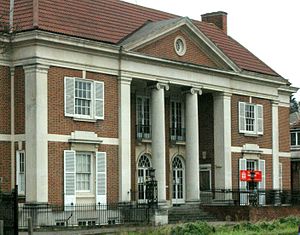Purley
| Purley | |
| Surrey | |
|---|---|
| Location | |
| Grid reference: | TQ313615 |
| Location: | 51°20’14"N, 0°6’51"W |
| Data | |
| Post town: | Purley |
| Postcode: | CR8 |
| Dialling code: | 020 |
| Local Government | |
| Council: | Croydon |
| Parliamentary constituency: |
Croydon South |
Purley is a suburban town in Surrey.
The town's name derives from pirlea, which means 'Peartree lea'. Purley has a population of about 72,000.
Contents
History
Suburban growth
Purley grew rapidly in the 1920s and 1930s, providing spacious homes in a green environment. Northeast Purley stretches into the chalk hill spurs of the North Downs.
One road, Promenade de Verdun, created by William Webb, has a distinction all of its own. It is 600 yards long and has on both sides Lombardy poplars planted in soil mixed with English and French earth specifically shipped over to the UK, and a plaque at one end with the inscription "Aux soldats de France morts glorieusement pendant la Grande Guerre", as a memorial to the alliance of World War One and the soldiers who died. At the other end of the road stands an obelisk carved from a single piece of stone. Notably, the town was home to Joachim Von Ribbentrop when he was ambassador before the Second World War and legend says that he ensured that the town was never bombed; though reality, the town was very heavily bombed.
The 32nd Surrey Battalion of the Home Guard was known as the Factory Battalion, and had the specific task of guarding the Purley Way factories: its units were mainly based on staff from the individual firms. The factories adjoining Croydon Airport took the worst of the air raid of 15 August 1940: the British NSF factory was almost entirely destroyed, and the Bourjois factory gutted, with a total of over sixty civilian deaths.
A comprehensive history of Purley and its growth around Caterham Junction (now Purley Station) with the coming of the railways some 150 years ago is found in the Bourne Society's 'Purley Village History' and in its Local History Records publications.
The Webb Estate made headlines in a 2002 survey, which found that it had over the years attracted the highest-earning residents in the United Kingdom.[1]
Aviation
Kenley Aerodrome, to the east of the town was one of the most important fighter stations – together with Croydon Airport and Biggin Hill – during Second World War. It is used within granted permission by a gliding association, and is a popular area where learner drivers can practice.
Retail and commerce
Purley used to have many different kinds of retail shops such as greengrocers, butchers, fishmongers, card shops, sport shops, etc. The old Sainsbury's was closed in the early 1980s (and has now been demolished as part of redevelopment plans by the congregation of Purley Baptist Church). Since the opening of Sainsbury's in the early 1980s (closed 2001) and, more significantly, a superstore in 1987, there has been a shift in the town's retail, predominantly charity shops, estate agents, restaurants and bars. In 2006, further change was on the cards as Tesco proposed to replace the store with a 6-storey building containing affordable flats above a new store. These expansion plans were subsequently shelved.[2]
The town centre has gradually moved upmarket, for example with the replacement of a gas showroom with The Rectory bar, and the introduction of new eating establishment. But the island around Purley Baptist Church remains tatty and the Church, under the banner of 58:12[3] (a company and charity set up by the Church) are planning to redevelop it. Other partners in the development of a strategy for the regeneration of central Purley include the Purley & Woodcote Residents' Association and Purley Rotary who actively participate in the Neighbourhood Partnership forums hosted by Croydon Council.
Appearance in fiction
- On television the town became known in the sitcom, Terry and June in which Terry and June Medford (played by Terry Scott and June Whitfield), had moved after the characters' previous series, Happy Ever After. The sitcom was set on the cusp of Purley and Wallington (on Church Road in a house within sight of St Mark's Church) and the opening credits featured them searching for one another around the (now unrecognisable) Whitgift Centre – a shopping precinct in central Croydon.
- One of the houses used in Footballer's Wives is in Purley.
- Purley is famous for a reference in both the Nudge Nudge and "Kilimanjaro Expedition" sketches by Monty Python. In the former the householders' statement that they live in Purley is met by "Purley! Say no more! Say no more, say no more, say no more, Purley!"
- In the theatrical version of Bram Stoker's "Dracula", Purley is the location of Dr Seward's sanatorium.
Nearest railway stations
- Purley
- Purley Oaks
- Riddlesdown
- Reedham
- Sanderstead
Outside links
- Local Gov. Site Promenade de Verdun
- History of Purley Village
- Purley's "58:12" Regeneration Project
- PWRA, Purley & Woodcote Residents' Association
- The Bourne Society, representing heritage interests in the debate over Purley regeneration
- Home of Purley John Fisher Rugby Football Club
- Online newsletter
References
- ↑ 12:01AM BST 16 Jun 2002 (2002-06-16). "Highest earners". Telegraph.co.uk. http://www.telegraph.co.uk/news/uknews/1397430/Purley-laughs-all-the-way-to-the-bank.html. Retrieved 2010-11-12.
- ↑ http://www.thisiscroydontoday.co.uk/displayNode.jsp?nodeId=250080&command=displayContent&sourceNode=250082&home=yes&more_nodeId1=250133&contentPK=19805691
- ↑ "58-12.co.uk". 58-12.co.uk. http://www.58-12.co.uk/. Retrieved 2010-11-12.
